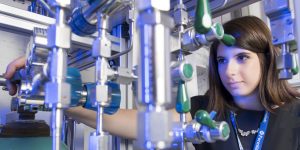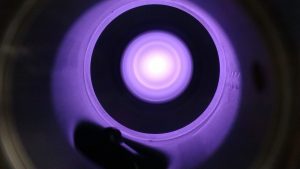
Bianca Giaccone’s award-winning research focuses on a technique called plasma processing. Here Giaccone is operating the vacuum and gas system used to flow gas through the accelerating cavities. Photo: Reidar Hahn
Bianca Giaccone, a Ph.D. student from the Illinois Institute of Technology working at Fermilab, has received the Young Investigator Prize for Best Talk at the International Conference on RF Superconductivity.
Her talk covered a technique for processing superconducting accelerating cavities.
Cavities are the components in particle accelerators that transfer energy to particle beams as they pass through. Superconducting radio-frequency cavities, or SRF cavities, in particular are the technology of choice for many future accelerators.
Along with partners at Oak Ridge National Laboratory and SLAC National Accelerator Laboratory, Giaccone and a group of SRF experts at Fermilab are working on a method for cleaning the inside of cavities made of niobium.
The main goal is to limit an unwanted effect called “field emission,” during which the cavity’s inner surface emits electrons. The more the field emission is reduced, the better, since electrons flying off the cavity surface can cause the cavity’s efficiency to plummet.
Scientists can reduce field emission in cavities by high-pressure water rinsing in cleanrooms. However, some contaminants may still fall on the cavity surface as the cavities are assembled into the larger building blocks that make up the final accelerator, called cryomodules.
Giaccone is working on a different technique, called plasma processing, originally proposed and implemented at Oak Ridge National Laboratory. Giaccone and the multi-institution plasma processing team are now developing an extension of this technique for cleaning cavities for the upcoming Linac Coherent Light Source upgrade, called LCLS-II, an X-ray laser currently under construction at SLAC.

This shows the inside of an accelerating cavity. A low-pressure, inert gas is necessary to ignite the glow discharge inside the cavity. Photo courtesy of Bianca Giaccone
By using plasma, they can treat the cavities’ inner walls even as they sit inside a particle accelerator. There would be no need to move or disassemble the cryomodules, which would be extremely costly. The technique has the potential of having a very high impact, as it can be applied to recover the performance of degraded cavities in accelerators worldwide.
On behalf of the collaboration, Giaccone presented the promising first results from tests of this method, which they applied to 1.3-GHz cavities for LCLS-II. One of the main innovations brought by the Fermilab team is an easier and more effective way to ignite the plasma in the cavities, as detailed in a recent paper published by the group.
The group plans to implement the technique on an LCLS-II cryomodule at Fermilab and eventually at the LCLS-II site at SLAC.
Giaccone is working on her thesis under the supervision of IIT professor John Zasadzinski and Fermilab scientist and Peoples fellow Martina Martinello.
The Young Investigator Prize for Best Talk is given to an individual based on the relevance and impact of the scientific work; the novelty and quality of the scientific work; the quality of the poster and oral presentation; and the individual’s interaction and professionalism toward the program committee.
This work is supported by a plasma processing grant from the Office of Basic Energy Science, and by the GARD facilities program of the Office of High Energy Physics in the DOE Office of Science.



